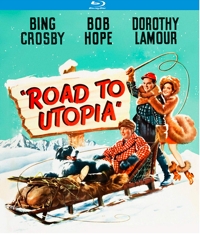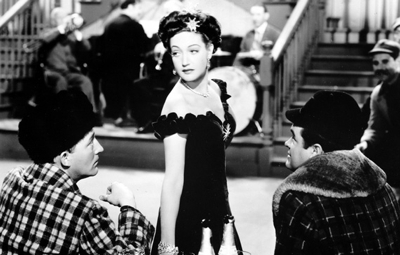 Grade: B+
Grade: B+
Entire family: Yes
1945, 90 min., Black & White
Adventure-Comedy
Not rated (would be PG for adult elements)
Kino Lorber
Aspect ratio: 1.37:1
Featured audio: DTS Mono
Bonus features: B-
Trailer
Amazon link
Like Road to Morocco, Bob Hope, Bing Crosby, and Dorothy Lamour’s fourth “road” picture, Road to Utopia, received an Oscar nomination for best screenplay—one reason why both of the musical comedies are considered the best of the bunch. There’s more plotting, more clever lines, and a more ambitious narrative arc in each of them.
The action takes place in Seattle and Alaska shortly after the Klondike Gold Rush around the turn of the century, making Road to Utopia (1945) the only road picture  with a historical backdrop. It’s also the only road picture to use a frame device that takes full advantage of the audience’s familiarity with other road pics. This time it’s made clear that Hope, not Crosby, got the “girl,” as the film opens with a made-to-look-old Hope and Lamour as a married couple who get a surprise visit from their old friend, Duke, and they reminisce about the adventure that led to their separation.
with a historical backdrop. It’s also the only road picture to use a frame device that takes full advantage of the audience’s familiarity with other road pics. This time it’s made clear that Hope, not Crosby, got the “girl,” as the film opens with a made-to-look-old Hope and Lamour as a married couple who get a surprise visit from their old friend, Duke, and they reminisce about the adventure that led to their separation.
In Utopia, Hope and Crosby play two vaudeville performers (what else?) who are working a scam called “Ghosto,” in which audience members are urged to wager money by placing it in a box to see if the “spirit” (Hope, as Chester, curled up underneath) will take the money and replace it with a larger bill. Duke (Crosby) wears the swami getup and solicits the cash, and all goes well enough until two murderers evading police chase through the theater. When the Ghosto table is overturned and the crowd sees it’s a scam, they take after Chester and Duke (Crosby), who scram with the money. After Duke swipes all of it and Chester follows him aboard the boat to get it back, the steamer horn sounds and they find themselves bound for Alaska.
It’s when Duke and Chester lose their money, stowaway, and are caught that the  plot really kicks into high gear and never downshifts. Forced to clean cabins, the boys stumble onto the gold mine map that everyone is looking for. Then, confronted by the murderers Sperry and McGurk, they somehow manage to subdue the men, shave off their beards, and swap clothes. Assuming their identity, they disembark in Skagway and learn in short order just how feared Sperry and McGurk really are. The fun, of course, comes from watching the cowardly Chester and mild-mannered Duke masquerade as tough guys (“I’ll have a lemonade,” Chester says to the bartender, adding, after realizing he’s broken character, “in a dirty glass!”). Some of the action takes place in a saloon, where there’s drinking and smoking and chewing tobacco, but the jokes and the boys’ trying to act tough take center stage.
plot really kicks into high gear and never downshifts. Forced to clean cabins, the boys stumble onto the gold mine map that everyone is looking for. Then, confronted by the murderers Sperry and McGurk, they somehow manage to subdue the men, shave off their beards, and swap clothes. Assuming their identity, they disembark in Skagway and learn in short order just how feared Sperry and McGurk really are. The fun, of course, comes from watching the cowardly Chester and mild-mannered Duke masquerade as tough guys (“I’ll have a lemonade,” Chester says to the bartender, adding, after realizing he’s broken character, “in a dirty glass!”). Some of the action takes place in a saloon, where there’s drinking and smoking and chewing tobacco, but the jokes and the boys’ trying to act tough take center stage.
In the chain of events that follows, Lamour plays Sal, whose father was murdered for the map. She thinks saloon owner Ace Larson (Douglass Dumbrill) and his gal Kate (Hillary Brooke) are going to help her get the mine back, but really they want it for themselves. And of course Sperry and McGurk, once they get loose, are also hot on the trail of the map and the men who are impersonating them.
All of the road pictures have moments where the fourth wall is broken, but in this one it’s done in a way that some might find more annoying. Former New Yorker columnist and humorist Robert Benchley introduces the film and interrupts the film occasionally in a freeze-frame insert of himself, commenting on what “we’re seeing.” When the film was made, the interruptions themselves would have seemed funny to audiences, but that’s no longer the case. And frankly, Benchley’s running commentary isn’t funny. It’s something to be tolerated or ignored.
 Thankfully the banter between Hope and Crosby is nearly as good as it was in Road to Morocco, and the plot is fun and fast-paced enough to where Benchley is easy to ignore. Though the music isn’t as catchy as Morocco, Johnny Mercer’s rendition of the song “Personality” hit #1 on the music charts, and Hope and Crosby’s “Put It There, Pal” is a pretty good BFF tune for the times.
Thankfully the banter between Hope and Crosby is nearly as good as it was in Road to Morocco, and the plot is fun and fast-paced enough to where Benchley is easy to ignore. Though the music isn’t as catchy as Morocco, Johnny Mercer’s rendition of the song “Personality” hit #1 on the music charts, and Hope and Crosby’s “Put It There, Pal” is a pretty good BFF tune for the times.
Older family members will appreciate this comedy of character and one-liners, while the action and the dogs and dogsledding—especially one Saint Bernard that “adopts” the boys—should keep the younger ones interested. If this were a race, Road to Morocco still finishes first, but Road to Utopia comes in a strong second.


Leave a comment